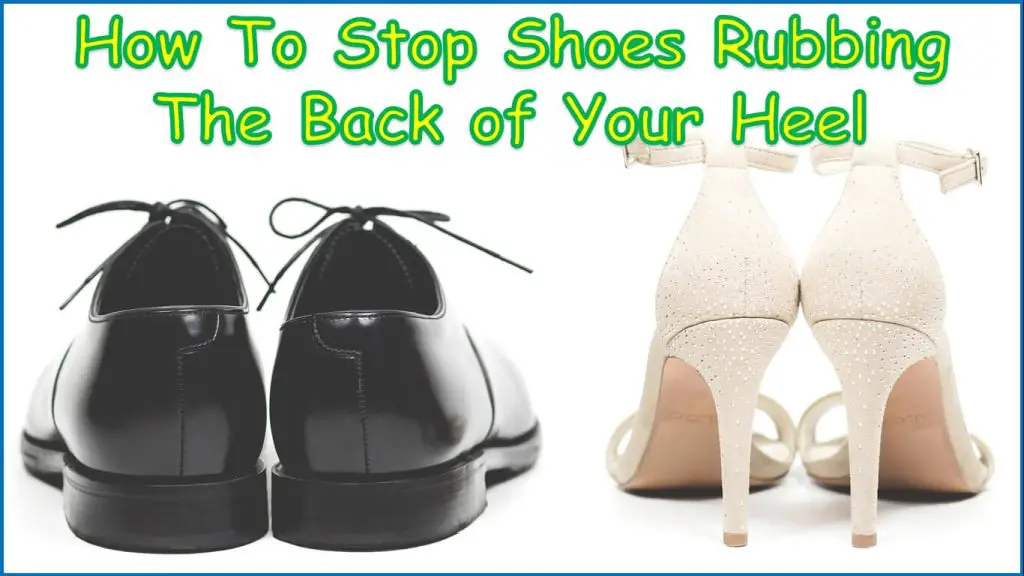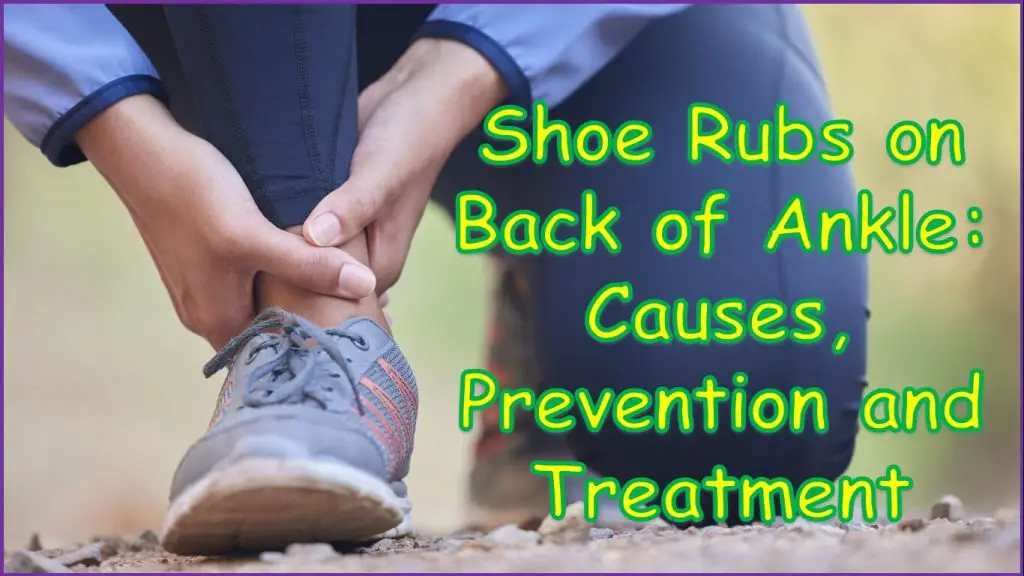As a podiatrist, I understand that shoes that rub against the back of your heels can cause a lot of discomfort and pain. Our skin can tolerate a certain amount of friction without causing any pain, such as when we scratch an itch. However, when shoes constantly rub against your heel, it can lead to injuries and pain.
Repeated friction can cause blisters or breaks in the skin, which are susceptible to infection. Over time, this can also lead to the development of bony bumps known as Haglund’s deformity at the back of the heel. Depending on the height of the shoes around the ankle, rubbing can also irritate the Achilles tendon and contribute to bursitis and other conditions.
To prevent this, I have compiled some top tips to help you stop your shoes from rubbing against the back of your heel:
How To Stop Shoes Rubbing The Back Of Your Heel?
1. During The Shoe Buying Stage
When you’re shopping for shoes, it’s essential to make sure you’re wearing the same socks that you plan on wearing daily. Many people try on shoes quickly while wearing stockings and then wear thicker cotton socks when they wear the shoes.
This reduces the available space and tightens the shoes, which can cause rubbing at the back of the heel and other areas of the shoe.
Additionally, it’s essential to buy shoes late in the day when your feet are swollen to get a better fit. Avoid shoes that are too tight, as they can also cause rubbing.
2. Choose The Right Socks
Blisters and rubbing can occur when socks don’t provide enough cushioning between your feet and the shoes. Some fashion socks prioritize style over comfort and protection. Opt for socks that have natural padding, are not too thin, and are made of materials that draw moisture away from the skin, such as merino wool.
Cotton, on the other hand, tends to trap moisture between the skin and the sock. As we age, our skin becomes thinner and more fragile, with less natural padding and protection.
If your feet feel more “prominent” than they used to, choosing socks with a good amount of cushioning and support can promote overall foot health and comfort and prevent rubbing.
3. Use Good Insoles
Pre-made orthotics that you slip into shoes without proper fitting can cause rubbing against the back of your heel. When you don’t control the height, shape, or fit of the insoles you add to your shoes, your heel may end up sitting at the top of the back of the shoe, which can encourage rubbing, especially if you have a prominent heel or Achilles tendon.
These orthotics can also take up more space than you have, leaving a tight fit that is prone to friction. If your job requires you to stand or walk all day, well-fitted and designed orthotics can prevent rubbing and friction.
4. Be Mindful Of Shoe Materials
Shoes made from mesh, coarse fabric, and other synthetic textiles are more likely to cause friction and heel blisters than shoes made from natural materials. We recommend breaking in shoes, but don’t expect them to stretch. Choose shoes made from good materials that feel comfortable and have a good fit from the start
Suede is a type of leather made from the underside of the animal skin. Ensure to get the right fit to start with and not compromise the fit with the socks you select. Leather can be hard and inflexible with unforgiving edges, so wear them around the house before spending days in them.
Cleaning and conditioning your leather will also help soften and make them more flexible. Canvas is often worn with bare feet and no sock protection, making it a common source of rubbing. Wear them around the house, bend them backwards and forwards, and adjust your lacing if they feel too tight.
5. Try Using Heel Cushions Or Padding
If you’re experiencing rubbing or discomfort on the back of your heel, heel cushions or padding can help alleviate the pressure and reduce friction.
These cushions are often made from gel or foam, and can be easily inserted into the shoe to provide extra support and cushioning where it’s needed most. Heel cushions can also help prevent blisters and other skin irritations from forming on the back of the heel.
6. Break In Your Shoes Gradually
New shoes can often be a source of rubbing and discomfort, especially if they’re made from stiff or inflexible materials. To prevent this, it’s important to break in your shoes gradually.
Wear them for short periods of time around the house before wearing them for longer periods or on extended walks. This will give the shoes time to adjust to the shape of your feet and soften up, reducing the risk of rubbing and discomfort.
7. Reduce The Moisture In Your Shoes
To reduce the moisture in your shoes, you can try using an absorbent powder like talcum powder to help keep the environment in your shoe dry.
You can also change your socks to a material that breathes better and wicks moisture away from the feet. If you feel your feet are sweating excessively, you may have hyperhidrosis. In this case, it’s best to book an appointment with a podiatrist to discuss treatment options.
8. Check For Rough Edges
Rough edges, seams, and layers of materials at the back of the heels can also cause blisters. If rough edges are digging in, rubbing, or irritating your skin, don’t resign yourself to using a bandage at the back of your heel every time. You may choose to sew moleskin pads over the rough areas at the back of your shoes or bring your shoes in for repairs to adjust any seams and stitching that have come apart.
By taking these steps, you can reduce your risk of developing blisters from your shoes. Remember that prevention is key, so it’s important to wear shoes that fit well, reduce moisture, and have no rough edges or seams that can irritate your skin.
9. Know When To Replace Your Shoes
Finally, it’s important to know when to replace your shoes. Over time, the materials of your shoes can wear down, become less flexible, and lose their ability to provide proper support and cushioning. This can lead to an increased risk of rubbing and discomfort. If you notice that your shoes are starting to show signs of wear and tear, it’s time to consider replacing them with a new pair.
In summary, there are many things you can do to prevent your shoes from rubbing against the back of your heel. By following these tips and tricks, you can help prevent blisters, skin irritation, and other foot problems, and keep your feet comfortable and healthy.
If you’re experiencing ongoing foot pain or discomfort, it’s always a good idea to consult with a podiatrist, who can help identify the underlying cause of your symptoms and recommend appropriate treatment.
You can also check out best shoes for heel pain here.
Causes Of Shoe Rubs On Back Of Ankle
Shoes That Are Too Tight
When shoes are too tight, they can press against the skin and cause friction, which can lead to blisters and calluses. If you experience painful shoe rubs on the back of your ankle, it could be a sign that your shoes are too tight.
Poorly Fitting Shoes
Shoes that don’t fit properly can also cause rubbing on the back of the ankle. When shoes are too loose or too tight, they can cause the foot to move around inside the shoe, which can cause friction on the back of the ankle. To prevent this, make sure your shoes fit properly and provide enough room for your feet to move comfortably.
High Heels
High heels can be a major culprit of Shoe Rubs on Back of Ankle. When you wear high heels, your foot is pushed forward, and the back of the shoe can rub against the skin on the back of the ankle. If you love wearing high heels, consider opting for lower heels or wearing flats for extended periods to give your feet a break.
New Shoes
New shoes can be stiff and not yet broken in, which can cause rubbing on the back of the ankle. It’s important to break in new shoes gradually and avoid wearing them for long periods of time until they are properly broken in. Start by wearing them for short periods of time until they feel comfortable, and gradually increase the time you wear them.
Stiff Shoes
Stiff shoes, such as boots and dress shoes, can also cause rubbing on the back of the ankle. These shoes can be inflexible and cause pressure points that rub against the skin on the back of the ankle. To prevent this, consider opting for shoes that are more flexible and have a softer lining.
Blisters
Blisters on the back of the ankle can be caused by a variety of factors, including shoes that are too tight, poorly fitting shoes, and high heels. When blisters burst, they can leave a raw, painful area on the back of the ankle that can be easily rubbed. If you develop a blister, avoid popping it and let it heal naturally. You can also cover it with a bandage to protect it from further rubbing.
Foot Shape And Bone Structure
Foot shape and bone structure can also contribute to shoe rubs on the back of the ankle. If you have a prominent Achilles tendon or a bony protrusion on the back of your ankle, it can be more susceptible to rubbing. In this case, consider wearing shoes with a softer lining or using cushioning pads and insoles to provide additional padding and support.
Are you tired of dealing with painful blisters and irritated skin from your shoes? Share this article with your friends and family to help them prevent and treat shoe rubbing. Let’s help everyone step comfortably and confidently!
#HowToStopShoesRubbingTheBackofYourHeel #FootcareTips #HappyFeet
See Also:
- Best Shoes for Cuboid Syndrome
- Best Shoes For Accessory Navicular Syndrome
- Best Shoes For Swollen Feet and Ankles
- Best High Heels for Flat Feet That Will Feel Like Sneakers
- Comfortable Shoes To Wear After Foot Surgery
- Best Shoes after Triple Arthrodesis
- Best Shoes for Ingrown Toenails
- Best Cute Sandals That Hide Bunions
- Best Shoe After Calcaneal Fracture
- What Shoes Are Good for Bunions
- How To Make Shoes That Are Too Big Fit


Leave a Reply